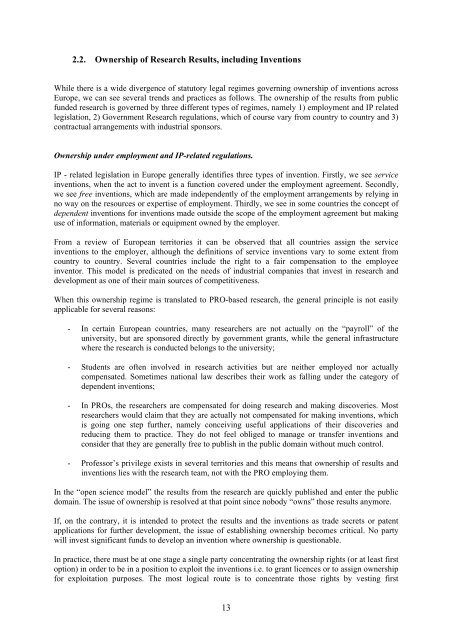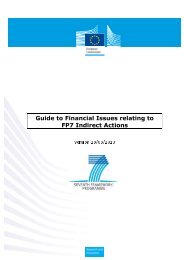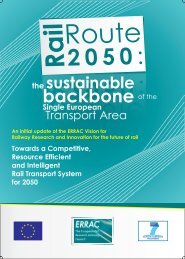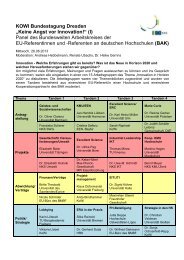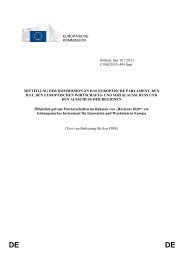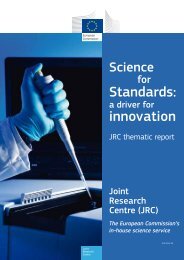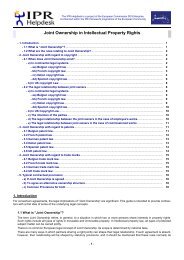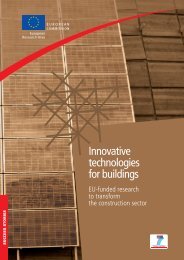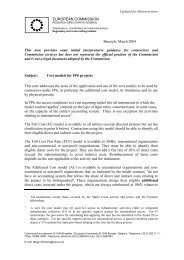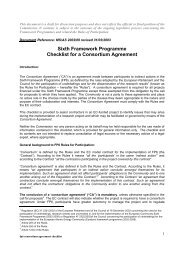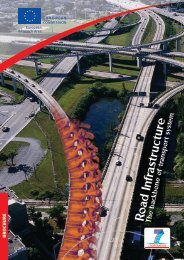Expert Group Report Management of Intellectual Property in ... - KoWi
Expert Group Report Management of Intellectual Property in ... - KoWi
Expert Group Report Management of Intellectual Property in ... - KoWi
Create successful ePaper yourself
Turn your PDF publications into a flip-book with our unique Google optimized e-Paper software.
2.2. Ownership <strong>of</strong> Research Results, <strong>in</strong>clud<strong>in</strong>g Inventions<br />
While there is a wide divergence <strong>of</strong> statutory legal regimes govern<strong>in</strong>g ownership <strong>of</strong> <strong>in</strong>ventions across<br />
Europe, we can see several trends and practices as follows. The ownership <strong>of</strong> the results from public<br />
funded research is governed by three different types <strong>of</strong> regimes, namely 1) employment and IP related<br />
legislation, 2) Government Research regulations, which <strong>of</strong> course vary from country to country and 3)<br />
contractual arrangements with <strong>in</strong>dustrial sponsors.<br />
Ownership under employment and IP-related regulations.<br />
IP - related legislation <strong>in</strong> Europe generally identifies three types <strong>of</strong> <strong>in</strong>vention. Firstly, we see service<br />
<strong>in</strong>ventions, when the act to <strong>in</strong>vent is a function covered under the employment agreement. Secondly,<br />
we see free <strong>in</strong>ventions, which are made <strong>in</strong>dependently <strong>of</strong> the employment arrangements by rely<strong>in</strong>g <strong>in</strong><br />
no way on the resources or expertise <strong>of</strong> employment. Thirdly, we see <strong>in</strong> some countries the concept <strong>of</strong><br />
dependent <strong>in</strong>ventions for <strong>in</strong>ventions made outside the scope <strong>of</strong> the employment agreement but mak<strong>in</strong>g<br />
use <strong>of</strong> <strong>in</strong>formation, materials or equipment owned by the employer.<br />
From a review <strong>of</strong> European territories it can be observed that all countries assign the service<br />
<strong>in</strong>ventions to the employer, although the def<strong>in</strong>itions <strong>of</strong> service <strong>in</strong>ventions vary to some extent from<br />
country to country. Several countries <strong>in</strong>clude the right to a fair compensation to the employee<br />
<strong>in</strong>ventor. This model is predicated on the needs <strong>of</strong> <strong>in</strong>dustrial companies that <strong>in</strong>vest <strong>in</strong> research and<br />
development as one <strong>of</strong> their ma<strong>in</strong> sources <strong>of</strong> competitiveness.<br />
When this ownership regime is translated to PRO-based research, the general pr<strong>in</strong>ciple is not easily<br />
applicable for several reasons:<br />
- In certa<strong>in</strong> European countries, many researchers are not actually on the “payroll” <strong>of</strong> the<br />
university, but are sponsored directly by government grants, while the general <strong>in</strong>frastructure<br />
where the research is conducted belongs to the university;<br />
- Students are <strong>of</strong>ten <strong>in</strong>volved <strong>in</strong> research activities but are neither employed nor actually<br />
compensated. Sometimes national law describes their work as fall<strong>in</strong>g under the category <strong>of</strong><br />
dependent <strong>in</strong>ventions;<br />
- In PROs, the researchers are compensated for do<strong>in</strong>g research and mak<strong>in</strong>g discoveries. Most<br />
researchers would claim that they are actually not compensated for mak<strong>in</strong>g <strong>in</strong>ventions, which<br />
is go<strong>in</strong>g one step further, namely conceiv<strong>in</strong>g useful applications <strong>of</strong> their discoveries and<br />
reduc<strong>in</strong>g them to practice. They do not feel obliged to manage or transfer <strong>in</strong>ventions and<br />
consider that they are generally free to publish <strong>in</strong> the public doma<strong>in</strong> without much control.<br />
- Pr<strong>of</strong>essor’s privilege exists <strong>in</strong> several territories and this means that ownership <strong>of</strong> results and<br />
<strong>in</strong>ventions lies with the research team, not with the PRO employ<strong>in</strong>g them.<br />
In the “open science model” the results from the research are quickly published and enter the public<br />
doma<strong>in</strong>. The issue <strong>of</strong> ownership is resolved at that po<strong>in</strong>t s<strong>in</strong>ce nobody “owns” those results anymore.<br />
If, on the contrary, it is <strong>in</strong>tended to protect the results and the <strong>in</strong>ventions as trade secrets or patent<br />
applications for further development, the issue <strong>of</strong> establish<strong>in</strong>g ownership becomes critical. No party<br />
will <strong>in</strong>vest significant funds to develop an <strong>in</strong>vention where ownership is questionable.<br />
In practice, there must be at one stage a s<strong>in</strong>gle party concentrat<strong>in</strong>g the ownership rights (or at least first<br />
option) <strong>in</strong> order to be <strong>in</strong> a position to exploit the <strong>in</strong>ventions i.e. to grant licences or to assign ownership<br />
for exploitation purposes. The most logical route is to concentrate those rights by vest<strong>in</strong>g first<br />
13


